BLOG
|
|
ALL YOU 5K 2023 Turkey Trotters who wish to run a New Year’s Eve 5k or a Resolution 5k Run on New Year’s Day and who would like a bit of STRUCTURE to get them pointed in the right direction to prepare for another fun event, this is for you. It’s adapted from earlier Earned Runs “On to the New Year” plans offered after Thanksgiving Day for those who followed an abbreviated 3 to 4 -week plan to get ready for their Turkey Trot. It will be posted on the Resources page.
You had nearly a week to recover from the Thanksgiving Day 3.1 mile run and mentally rest up. The general rule is to avoid intense workouts for a length of time determined by the race distance: 1 day for every 1 mile of race. Thus after a Thanksgiving Day 3.1 mile (5K) race you would take 3 days to rest, with only easy short runs, cross-training sessions, or walking. This plan starts November 29, today, at about the level of intensity scheduled just before Thanksgiving Day.. OR you can devise your own plan to prepare for an event roughly 4 weeks later. Either way, think about using the past several months’ training effort to position yourself for a vigorous end to the year 2023 or confidence boosting beginning to the year 2024. RUN AND MOVE HAPPY
0 Comments
GOOD LUCK TO ALL THE TURKEY TROT participants who will be lining up for an event tomorrow. If you’re running by yourself or need to find a mental exercise to help get you past the rough spots on the route, check out this article by Kara Cutruzzula on SHAPE.com. "Why You Should Go On A Gratitude Run". It must be a classic as it was published in an earlier year and updated in 2020.
If on your own for a holiday run or walk, what better Thanksgiving Day “exercise” than an outdoor session spent reflecting on the good things in life worthy of thanks? RUN & MOVE HAPPY! https://www.shape.com/fitness/cardio/why-you-should-go-gratitude-run AFTER RUN STRETCHES, FOAM ROLLING, AND DEAD BUGS for Earned Runs Turkey Trot Preparation Plan 2023 The details of Earned Runs’ 22-Day Turkey Trot Preparation Plan include preparing for your walk-run sessions with MYRTLs, then following up with stretches, and intermittently performing a foam rolling routine and dead bug exercise.
MYRTLs were discussed in the previous post. This post will provide a link with information about post-run stretches and how to perform them, and other links to demonstrate foam rolling and dead bugs. Post-Run Stretches Andrea Gaini wrote a piece for RunnersWorld.com that demonstrates commonly prescribed moves. THESE ARE STATIC STRETCHES. The broader topic of stretching is very complex. If you care to read an in-depth discussion about static versus dynamic stretches and when to perform them check out a previous ER post (https://www.earned-runs.com/blog/science-friday-static-stretching).* Foam Rolling: Bob and Brad are physical therapists that together offer solid advice on musculoskeletal issues of importance to runners and walkers as well as just about anyone. They are the first source I look to for safe and practical ways to accomplish training goals or fix problems that require exercises or other PT moves. Check out their version of the routine if you’re new to this post-exercise or pre-exercise warm-up technique. See another link below or check out the RESOURCES page for more links. Michael Easter has a piece on how foam rolling works that is referenced in a previous ER post. Urban Kick YouTube https://www.youtube.com/watch?v=WCj1dvTwOF0 Dead Bug The DB exercise strengthens your CORE - abdomen and lower back. I learned this move using a stability/Swiss ball. The Juniper Physical Therapy video shows how to perform the DB with a ball. The Crossfit demonstration shows how to make the exercise easier then progressively more difficult, and using a block. I learned using a ball held in place by one leg and opposite hand and holding the position of one leg/one arm down for a count of 3-5! Read a previous RESOURCES page article for more discussion on the importance of core stability. (The image above reflects the discussion in the RESOURCES article about the importance to running of having a strong body chassis like an automobile https://strengthrunning.com/2011/11/dont-let-your-engine-outpace-your-chassis-how-to-build-a-strong-body/) RUN & MOVE HAPPY! *My personal approach to stretching is to perform several passive (referred to here as post-run) stretches before getting out of bed most mornings to help with overall flexibility and mobility as an older high mileage runner, and to help prevent plantar fasciitis, which I am prone to develop. I usually run more than an hour after performing them, and except rarely, will not be focused on performance in a race. Dynamic stretches are done just as I'm heading out to run. Bob and Brad Physical Therapists Foam Roll Routine https://www.youtube.com/watch?v=TvTNfKMreMM Michael Easter for MensHealth.com https://www.menshealth.com/fitness/a19515618/truth-about-foam-rolling/ Juniper Physical Therapy & Fitness https://www.youtube.com/watch?v=jxmI_l7sTSw Monica Ksel: Dead Bug with Stability ball https://www.youtube.com/watch?v=bUfeEgFly8w CrossFit Lakeland Dead Bug Progression (easy - difficult) https://www.youtube.com/watch?v=UR_lWjVpfAM NeckandBack.ca Beginner Dead Bug without ball https://www.youtube.com/watch?v=LrvQ5deTBMY Robert Gillanders Dead Bug Progression; legs only to legs plus arms https://www.youtube.com/watch?v=8NBNM8haZx0 https://www.runnersworld.com/uk/training/beginners/a32172701/how-to-stretch-post-run/ Earned Runs Core strength BLOG post (updated 11/14, 2023) https://www.earned-runs.com/blog/science-friday-static-stretching The 22-day Earned Runs 2023 Thanksgiving Turkey Trot Preparation Plan is a day-by-day schedule designed to help last minute participants train to cross a finish line injury free on November 24. It’s not a traditional 12, 10, or 8-week long program that promises to turn “couch potatoes” into runners.
The purpose of this plan is to allow those who hope to join in the fun of this event by alternating walking and running intervals. Individuals should be actively walking at least 15 minutes in one session regularly and feel ready and able to run for a duration of 1 to 5 minutes at a time. This plan introduces novices to warm-up (MYRTLs) and cool-down (post-run stretches) routines, a self-massage technique (foam rolling), and one core strengthening exercise (dead bug). There are many other routines, techniques, and exercises that benefit runners and walkers and improve performance. But as some followers have commented, 22 days is not enough time to comprehensively train! A hidden plan purpose is to excite some to continue training after Thanksgiving Day, as confidence and competence is built over just these few weeks, and the process is enjoyed as much as the race. The less discomfort, the greater the ease with which each day’s workout will be accomplished, thinks Earned Runs, and the more enjoyable the experience. For this reason a few training practices are being introduced to smooth the way. So, what’s a MYRTL and what is it doing on a training plan? “MYRTLs” is the nickname used by coaches and trainers for a series of hip-girdle mobility moves designed to loosen hips made stiff by lots of running, lots of sitting, and by lots of both! The mechanism behind the utility of such moves, according to coaches/trainers that promote these routines, involves a process called “imbibition”. Because cartilaginous and other tissues that contribute to hip joint structures are avascular*, hydrating fluids are not delivered to them through blood vessels (like in most other body tissues) but are forced into them by movement. The tissues imbibe or “drink” the fluid which fills the joint space. MYRTL moves enable imbibition, they say, kind of plumping and “juicing” these tissues, such that they can provide cushioning and allow smooth joint movement. Each Individual MYRTL move forces fluid in a different direction within the joint space. I’ve yet to find scientific references that address the athletic aspects of this teaching. However, my hip movements seem to be much improved from personal experience (discussed below) with MYRTLs after a significant strain. I continue to perform MYRTLs before workouts, and after roughly 10 years, haven’t noted adverse effects. And have no problems getting on and off my fat tire bike! The links below demonstrate how to perform a routine before you head out to train. Enjoy mastering MYRTLs and becoming an athlete as you train. RUN & MOVE HAPPY! MRYTLs Demonstration by Wolf Creek Track Club USATF Registered Coach Brandon Wise https://www.youtube.com/watch?v=nmHjMCN0nx0 Runner’s World Australia and New Zealand demonstration: https://www.youtube.com/watch?v=Mj8uZ1Qtx3M *Anatomy, Cartilage (Stat Pearls) https://www.ncbi.nlm.nih.gov/books/NBK532964/ FYI Below is part of a previous post on this topic: “DISTANCE RUNNERS DEVELOP STIFF HIPS, AS DO PEOPLE WHO SIT A LOT. In the former group, tightness or stiffness of the hip joints is caused by the repetitive movement of endurance running combined with weak gluteal muscles, according to an article from Athletico Physical Therapy on hip flexor stiffness. The article also indicates that in people who sit a lot stiffness is, “well, caused by sitting a lot.” I noticed my own hip stiffness after taking a new bicycle out for a long ride in the early spring years ago. Back then my weekly running mileage was the most it had ever been. I had attempted to lift and swing my right leg back and over the bike seat to dismount. The move was difficult and required my leaning the bike very close to the ground to lower the seat height enough to clear it with my leg During the dismounting motion I felt a sudden painful pull. Oh, oh! Five months of rest was required to recover from whatever happened in my right hip area. After the injury resolved I noticed that maneuvering one leg over any low barrier, like a chain fence or wall, still required special effort. I worried about incurring another injury and decided to seek professional help. As a result, clams, leg raises, and other hip strengthening, mobility, and balance building exercises became a part of my daily/weekly routine about 10 years ago. At the time, I was told gluteus medius strength must be addressed, as this muscle helps to stabilize the pelvis during forward running and weaknesses or imbalances can lead to knee and other joint problems. And that a mobility routine would loosen my stiff hips. “MYRTLs” is the nickname used by coaches and trainers for these hip-girdle mobility moves. Much later I learned that MYRTLs act to hydrate joint tissues, helping to prepare cartilage, ligaments, and tendons for smooth running. Coaches and trainers commonly prescribe hip mobility routines to runners for the purpose of “juicing the joints” (in Coach Jay Johnson's words) in preparation for workouts, often combining them with exercises that build hip muscle strength.” 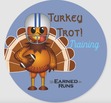 NOTE: The very earliest Earned Runs blog posts were to introduce followers to the Turkey Trot tradition in America. As posts now resume after 2 years of a hiatus, it seems most appropriate to address this topic again. Turkey Trot events are so much more than competitions. The following is an update of the 2015 post GET READY! Decide today that you’ll participate in a Turkey Trot (TT) event in 2023. Whether or not you’ve trained to run a 5k distance, there’s fun to be had joining crowds of others in an organized race or planning a custom event with a small group. You might also consider a solo outing that sets a personal first effort time or improves on an existing personal record (PR). For many years I ran my own solo race before getting to work in the kitchen preparing food for our feast later that day. An article by Jenny McCoy for RunnersWorld.com, “How the Turkey Trot Became the Most Popular Race in America,” might inspire some to get going. Honor an existing TT tradition or establish a new one. Regardless of what you have done on past Thanksgiving Days, change up this year’s effort to fit circumstances as needed. The pandemic has wreaked havoc on family and friend traditions for many since 2020. We now realize alternative celebrations can be meaningful and fun but require ingenuity and flexibility to pull off. A Turkey Trot can be walked, skipped, walk-run, or run. The start and finish lines can be crossed pushing a stroller in many races Youngsters manage to successfully utilize a combination of all these moves. The 5K distance is 3.1 miles. A brisk walking pace will allow a finish in less than an hour, plenty of time to return home and eat a slice of breakfast pie! Not excited about a 5K? Make it a fun one-mile distance, or a longer competition. Your first step will be to identify a race near home or location of the dinner you hope to enjoy that day, if an organized event is your style and is feasible. Or request Earned Runs bibs for a custom designed solo or smaller group competition. Most simply, decide you will manage without bibs. The next step will be to use the few weeks prior to Thanksgiving to prepare physically for the event. You may have a tried-and-true training regimen in mind. If not, an internet search can provide advice and free plans. However, most plans will be 4 or more weeks in duration and require adjustment to a 22- day schedule, if you're starting today. . Earned Runs has a plan designed to help you prepare to safely run/walk a 5k distance over just these few weeks. Check it out at the end of this post. Before you head off to train, here’s a bit more background on the Turkey Trot in America from a 2015 blog: Buffalo NY has a solid place in the history of the event, as it held the first TT in America in 1896, sponsored by the YMCA. It was an 8K, not the shorter 5k that is popular today. The article explains how the tradition grew and expanded. One historical fact jumps out: women were not allowed to run the Buffalo race until 1972!!! It had not occurred to me before reading this piece that women were excluded from this (and probably other) holiday event for so many years. It makes sense that 1972 would be the year the race opened its gates to female runners; in April that year women were finally included in the Boston Marathon. Are you fired up yet? Here's a link to a race finder site (Running in the USA) to help you locate a holiday race nearby. This post has a link to the REQUEST BIBS page. Still need encouragement? What if you knew costumes were common and welcomed at Turkey Trot races? Read the Runners World article “10 Delightfully Weird and Wonderful Turkey Trot Costumes” for more about this race day custom. Start planning todayl There are only 22 days before the holiday, If you will be involved in preparing dinner and don't think you can manage getting to and from an organized race, run/walk a personal customized race like I have in years past. REQUEST Earned Runs bibs to make your effort a bit more official, RUN AND MOVE HAPPY! 2023 Earned Runs Turkey Trot 22 Day Preparation Plan https://www.runnersworld.com/thanksgiving/how-the-turkey-trot-became-the-most-popular-race-in-america https://en.wikipedia.org/wiki/Boston_Marathon https://runningintheusa.com/race/find-by-state/ https://www.runnersworld.com/thanksgiving/10-delightfully-weird-and-wonderful-turkey-trot-costumes https://sparkleathletic.com/thanksgiving-running-costume-round-up/ 22-day Preparation Plan to run/walk a 2023 Turkey trot 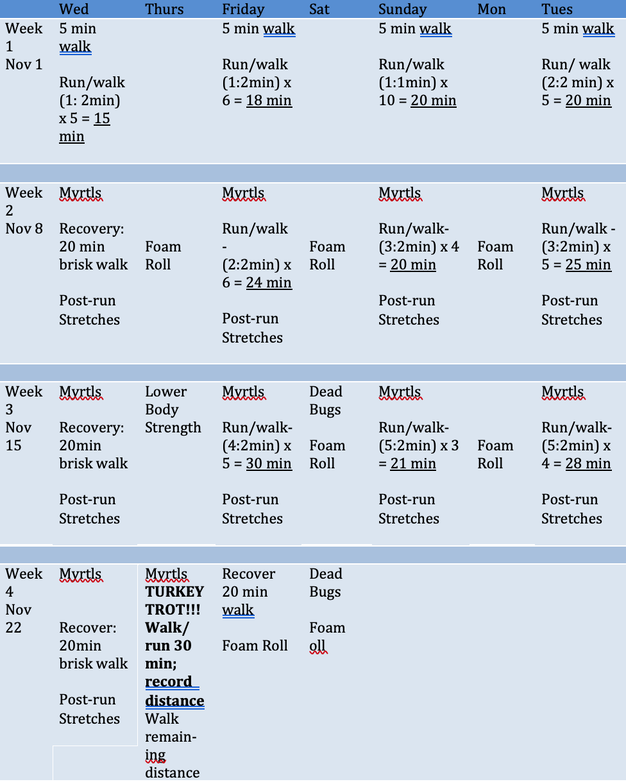 to Note this plan starts today, Wednesday November 1, 2023. Each subsequent week begins on a Wednesday. Also note that on the Turkey Trot Race Day the schedule says to run/walk 30 minutes, record the distance, then walk the remaining distance. The plan prepares you to run/walk 30 minutes so if you cross the finish line before then, you're done! If not you can continue to run/walk but the best insurance against injury is to cover the 30 minute distance at your training pace, then take it easy for any remaining distance. It's important to try to make note of (guesstimate) the distance so that you know what you were able to accomplish in 30 minutes if not yet at the finish line. Hopefully the thrill of competition will encourage you to continue training, commit to another race, and eventually complete a goal race fully prepared for that distance. The purpose of this short Preparation Plan is to allow participation in a great American tradition in 2023 despite only a few weeks of training. RUN AND MOVE HAPPY! 2023 Earned Runs Turkey Trot 22-day Preparation Plan WHETHER OR NOT YOU ARE CONCERNED* WITH DIETARY INTAKE of essential and non-essential polyunsaturated fatty acids, (PUFA) you may have encountered the hype surrounding this nutritional issue. The simplified bottom line over the past few decades has been that “Omega-3’s” are good and “6’s” are not.
Thus, consumption of foods and supplements rich in omega-3 fatty acids EPA (eicosapentaenoic acid) and DHA (docosahexaenoic acid) like fatty fish (salmon, mackerel, sardines) and plant seeds (flaxseeds and chia seeds) has been promoted to improve cardiovascular health. Because foods that most commonly show up in our Western diets as the biggest sources of omega-6 fatty acids include snacks and other highly processed convenience/junk foods, rich sources of calories and fats in general, the 6’s have been considered the type of fats to avoid. What’s worse is the reputation difference between 3’s and 6’s in terms of inflammation potential. Omega 3’s have been cast as anti-inflammatory heroes; omega 6’s have been labeled as pro-inflammatory villains. This is an important distinction because long term, low-level, systemic (body-wide rather than localized) inflammation is known to be behind the development of many chronic conditions including cardiovascular disease, diabetes, neuro-degeneration, and cancer. https://www.nature.com/articles/s41591-019-0675-0 As a former dietitian all this information seemed to logically support the simple “3’s are good” and “6’s are bad” labels. That is, until I realized that “healthy” olive oil of Mediterranean Diet fame, is low in Omega-3 and high in monounsaturated and omega-9 fatty acids (another PUFA). And when scientific articles began to appear in my regular email updates from the NIH Library of Medicine that nuts and seeds should be increased in our diets, especially walnuts. Nuts and seeds are high in fat, and many are rich sources of omega-6 fatty acids. What? https://pubs.rsc.org/en/content/articlelanding/2012/FO/C2FO10152A [Before continuing further, a definition is in order. All PUFA molecules have a side chain comprised of multiple carbon atoms. The carbon atoms in the chain are connected to each other, joined by a single or “saturated”, carbon-to-carbon bond or a double, “unsaturated” C-C bond. PUFAs have many (poly) unsaturated bonds; saturated fats have, well, saturated single bonds. The Omega-3 PUFAs have one of their carbon-to carbon double bonds in the three position (third from the end of the chain). The Omega-6 PUFAs have one of their double/unsaturated bonds in the six position (sixth from the end).] https://www.ncbi.nlm.nih.gov/pmc/articles/PMC7037798/ Searching and reading for better understanding on this issue, I learned that the ratio of intake of the different omega’s to each other also effects health. Researchers think that early humans evolved consuming a ratio of about 1:1 (omega-3 to omega-6) fats, and experienced lower levels of lifestyle-related heart disease and diabetes than modern humans. Our Western diets typically provide a whopping 1:16-20 ratio of omega-3 to omega-6!!! https://www.healthline.com/nutrition/optimize-omega-6-omega-3-ratio I knew, in addition, that the story is complicated by the fact that excess adipose tissue in our bodies also generates inflammation. So, by ingesting the many calories contained in “bad 6’s” snack food fats, we tend to make more calorie storage (adipose or fat) cells that increase our risk of living in the harmful state of chronic inflammation for decades. https://www.nature.com/articles/s41591-019-0675-0 My take was that it is best to strive to consume a 1:1 (omega 3: omega 6) ratio by: -decreasing my intake of excessive junk omega-6 fats that would add inflammatory adipose tissue (fat cells) -substituting them with healthier omega-6 rich nuts and seeds, especially walnuts -and adding more omega 3’s in whole foods I thought my mental game approach to the 3’s and 6’s was in place and ready to put into practice. However, recently I happened across a relatively short August 2019 Harvard Health Bulletin article that called into question the pro-inflammatory influence of omega-6 fats. https://www.health.harvard.edu/newsletter_article/no-need-to-avoid-healthy-omega-6-fats The piece indicates that an American Heart Association (AHA) advisory committee, ”two years in the making”, believes that intake of dietary omega-6s benefits cardiovascular health. And that research has debunked the charge that most omega-6 Linolenic Acid (LA) is converted to precursor molecules (arachidonic acid) that promote inflammation. Other newer scientific articles also seem to shift away from making blanket statements labeling omega-6’s as pro-inflammatory but less clearly and boldly. This change in perspective is best explained in the Harvard Health piece, “No Need to Avoid Healthy Mega-6 Fats”, the reason for this blog post. To me it’s almost a 180-degree turnaround from what has been preached by academic nutritionists and seconded by amateur experts. I expect to see more reversals as researchers shift approaches to the study of human nutrition and disease. My personal healthy-fat-intake strategy (outlined above) won’t be drastically changed because of learning of this new viewpoint, but my reading of the literature going forward will be altered. I’ll be looking to learn of other attitude shifts in the scientific community toward dietary fats, including saturated fat, especially in dairy foods. In the future, other foods that were considered harmful may be found to be helpful in promoting health, when taken in context of how much is ingested, especially relative to what else is eaten. *Why does this matter to athletes? Because our dietary choices should be informed rather than misinformed, so that our good exercise habits aren’t negated by poor nutrition habits but rather boosted by them. It’s a shame to avoid foods and snacks that we find help us perform during and recover after athletic efforts if we mistakenly think they are “bad.” Hopefully manufacturers will take note and offer new and improved products. Check out the Harvard article for a nicely written explanation of why the “6’s” don’t need to be avoided but balanced with “3’s” closer to a 1:1 ratio than a 20:1 ratio, and which sources of each are best. RUN & MOVE HAPPY! https://www.webmd.com/diet/features/what-to-know-about-omega-3s-and-fish https://www.mayoclinic.org/diseases-conditions/heart-disease/expert-answers/omega-6/faq-20058172 GETTING OUT EACH MORNING, DAY, OR EVENING TO RUN OR WALK COMES NATURALLY TO THOSE WHO LOVE THESE FORMS OF EXERCISE. However, most of us can benefit from at least one to two days off a week for the purpose of injury prevention. Cross training can be a way to reduce the risk of bodily harm due to overuse. According to an article, "6 Ways Cycling Will Help You Be a Better Runner" by Rick Prince posted by podiumrunner.com, riding, both outside and indoors, not only helps avoid this problem but can actually improve running performance. The piece explains why cycling can improve running (and surely walking too). The paragraph headings relate how this exercise: -Mimics (running) Movement -Strengthens Calf Muscles -Strengthens Shin Muscles -Engages the Core -Builds the Aerobic Engine -Boosts Anerobic Systems If not certain how to properly cycle-cross train to help your running (or walking) performance, the next article (it follows the Prince piece after a number of ads…just keep scrolling down) by Jonathon Beverly provides an indoor cycling workout for this purpose. Beverly’s expert on the topic, Tom Miller PhD, outlines ‘The Standing Hill Interval Training’ session he uses in his coaching and personal life. Miller’s credentials are impressive. The article indicates he’s won the 75-79 year age group in “two of the last three Xterra Trail Running National and World Championships”. Enough said; I’m in. RUN & MOVE HAPPY! https://www.runnersworld.com/health-injuries/a20819497/the-10-laws-of-injury-prevention/ https://www.podiumrunner.com/training/cross-training/why-cycling-is-a-great-cross-training-option-for-runners [THIS UPDATED VERSION WAS INITIALLY POSTED IN 2017. Read it this year if you haven't yet done so. Regardless of intentions to participate in an upcoming November holiday event, both runners and walkers may learn why training on a regulation track may help reach a variety of PHYSICAL ACTIVITY goals in the remainder of this year and the next.]
"IT'S YOUR MOVE! Consider training for a Thanksgiving Day Race in 2021. Unlike 2020 in which the majority of such activities were virtual, there’s a chance that this year most will be held as in-person, real-time events. CHECK OUT the Earned Runs 2021 Turkey Trot Training Plans for runners and walkers (see PDF links below or RESOURCES page). Each is designed to help first-timers prepare to participate in one of the many Thanksgiving Day events that are likely this year to be held across the USA. Not much has changed from the 2020 plans except that they are a week longer. As before, runners have the option of training on a 400-meter track one day a week. The first day of each plan is this upcoming Monday, September 13, 2021. There are a few days before a decision must be made to participate and start training. If it’s a “go”, jump right in and perform the first day’s scheduled workout, letting that experience help you commit to the full 10+ weeks leading to November 25. The running plan was adapted from one developed by Mario Fraioli for Competitor.com (now organized as PodiumRunner.com a part of Outside). The walker plan was adapted from plans offered free online by Hal Higdon. The fact that the Fraioli 5K running plan had a track day scheduled each week was one of the reasons it was selected by Earned Runs for beginners. The TRACK DAY option provides motivation to find a regulation track and take advantage of the potential benefits to be gained from feeling comfortable using one to train. The following is an updated explanation for this choice that was initially posted in 2017. “Why TRACK DAYS?” A TRACK IS A TYPE OF FITNESS EQUIPMENT Many beginning or would-be runners and walkers, may not have ever run, trained, or walked on a standard track. They may not know where the nearest or most accessible high school, college, or community facility is located. It may seem to be a training site that is off bounds to them, and more appropriately used by younger or more ‘serious’ athletes, who are fast, highly competitive, and in top physical shape. In my experience as a recreational walker/runner, there are three characteristics that make a track an essential piece of equipment that all runners and walkers should learn to consider a training ‘home’. A track is MEASURED, SAFE, and ATHLETIC. MEASURED: Specific distance assignments in a plan can be difficult to mentally assess for those accustomed to ‘just running’ or 'just walking' rather than training, especially over shorter rather than longer stretches. A GPS-assisted device can be used to chart a course in miles or kilometers but it requires repeatedly checking that device to be precise with shorter distances. Visually marking exact distances by this method to avoid such device-checking is problematic too, as rarely are there memorable physical features at needed points to help recall the start and end of a set distance. (“Which tree marks 400 meters?”). If a training plan calls for varying distances the measurement difficulties are compounded. A standard track lap or fraction of a lap is a limited distance that looks the same every time you run or walk it. Memorizing a series of landmarks isn’t required to determine the exact distance run or walked. Mentally, a standard track is nearly effortless to use. The track’s straight lengths are easily distinguished from the curved ends, each of which which can be employed for quick successive changes in pace. The time it takes to cover specific distances is relatively easy to measure on a watch or mobile device. I've found that using a track regularly for training helps my body develop a ‘memory’ for different distances. SAFE: Safety is a life quality that has several dimensions: training safety, weather safety, endurance safety, traffic safety.. Training: A running surface can be more or less safe from a training injury prevention perspective, especially when workouts will be performed at higher speeds or in adverse weather conditions. A running track used for competition tends to be even, consistent, textured, slightly cushioned, and appropriately drained. This type of surface, designed for officially certified events, is more likely than others to be safe for running faster-paced, precise intervals. Weather: Your regular road or trail running course may offer various degrees of protection from harsh elements, depending on the potential for exposure to extreme environmental conditions. Or it can leave you far from protective shelter when weather conditions are expected to deteriorate over the duration of a single long workout. On days in which the atmosphere might be hotter, colder, windier, or wetter than is desirable for performance or health, a track session may be the top safety pick. Although running or walking multiple loops of a neighborhood street course has been my preferred approach on such days, a track will do nicely when one is not readily available. On the toughest weather days, a track may beat a street course because supportive gear can be made more accessible. Hydrating fluids, nutrition, and dry, cooling or warming clothes can be stowed in a bag and left in full view at the edge of the track on bleacher seats, only a single lap away, or in a nearby parked car. Endurance: When a runner/walker is uncertain about being able to complete a given workout in its entirety, especially if longer or more difficult than previously experienced, the track can be a great place to safely test individual limits of endurance. You aren't as likely to find yourself miles from the end of tougher than expected finish during a never-before attempted session. Traffic: Personal safety in traffic is another concern of outdoor runners and walkers. Compared to busier urban thoroughfares, a track open only to foot traffic poses minimal to no risk of bodily harm from accidents caused by faster moving vehicles. Especially now that dedicated lanes near the street curb have been marked off for the use of bicycling commuters, rush hour exercise requires environmental awareness of all traffic dangers including those related to poor visibility in lowlight conditions. Some runners and walkers prefer isolated paths or suburban and country roads for avoidance of crowds. However, in cases of emergency these are places where the likelihood of receiving timely assistance from passers-by is diminished. A track can also be unsafe if in an area that is poorly lighted, out of the sight of others, or without security monitoring. Checkout the active.com article by Lauren Hargrave, which provides personal safety tips for runners. ATHLETIC: Performing a workout on a track is one way for beginners to feel and act like the athletes they aspire to become. Acquiring this mental attitude will help a runner or walker persevere in the tougher training regimens and possibly to adopt healthier eating and sleeping habits. The track is also a user-friendly place to perform pre-run dynamic stretching and mobility routines and to get in post-run static stretches as well as body-weight strength exercises (step-ups and step-downs, plank variations, and push-ups, etc) on benches and stairs. Holding to the rule that you cannot start the running/walking portion of the workout or depart from the premises before completing necessary routines increases the chances they will NOT be skipped. In some races the finish line is located on a track and the very last portion of the race includes a partial lap. Performing some workouts on a track can help beginners to visualize a successful goal race finish. Despite the encouragement of Earned Runs, the track may not be a desirable place to train for some. The Track Day Schedule identifies the approximate distances that should be run that day to help you accomplish the session goals without utilizing a track. GOOD LUCK! RUN & MOVE HAPPY! RUNNERS PLAN FREE PDF WALKERS PLAN FREE PDF 2017 TRACK DAY SCHEDULE 2017 Mintues to Miles calculations https://www.halhigdon.com/training-programs/15k-10-mile-training/intermediate-15k-10-mile/ https://www.active.com/running/articles/6-running-safety-tips PREVIEW THE RUNNING AND WALKING training plans for 2021 if you are interested in participating this year. Last November many traditional races were cancelled or held as virtual events. The usual atmosphere of community and celebration was missing though, because we were fearful and mostly prevented from gathering in large groups by local rulings.
Hopefully this autumn will mark the return of in-person organized events. Even though previously many may not have wanted to join in such festivities, perhaps this year participation will be viewed differently. For me the change in viewpoint led to enabling inclusion of neighbors to the north of Michigan in training plans for a Thanksgiving Day event, which in the USA falls in late November. Ever since our (sadly departed) Newfoundland pup’s 1995 travel itinerary to the USA was changed to accommodate the breeder’s wish to celebrate Canadian Thanksgiving Day with her family, I’ve taken note of their national celebration in October each year. In 2021 it falls on Monday the 11th. The earlier date Canadian holiday has a longer history than that of the United States observation, partly because it reflects the different growing season and harvest period. Having visited and dined in Quebec, Ontario, and British Columbia provinces in Canada, there’s no doubt it’s an amazing day of gathering and feasting! [I’m especially eager to again enjoy the cuisine of La Malbaie in the Charlevoix -Est district of Quebec] Unfortunately, this post and the plans are not as early as they should be to allow a full 10-week training period, so abbreviated Canadian Thanksgiving day RUN and WALK plans are posted on the RESOURCES page as of today. Perhaps some to the north will start now and then continue to follow afterward with the Turkey Trot schedules. A separate posting will describe the 5K RUN and WALK Turkey Trot plans in detail, designed to prepare for the USA November date. Because Thanksgiving is a traditional holiday anywhere in the world it is celebrated, the Earned Runs training plans are traditional as well. They have not changed much over the years, nor have the blog posts. But the notion that we are potentially able to return to our “same old” seasonal observances warms my heart. Check out the “same old” Earned Runs Turkey Trot plans and the new shortened Canadian plans and think about making room in the upcoming weeks and months to prepare for joining friends, family, and neighbors in local events. Like the return of pumpkin spice lattes and other similarly seasoned beverages and items on coffee shop menus each year, perhaps the beginning of Turkey Trot training will conjure up cozy autumn scenes and fond remembrances. RUN & MOVE HAPPY! https://www.thecanadianencyclopedia.ca/en/article/thanksgiving-day https://en.wikipedia.org/wiki/Newfoundland_dog https://en.wikipedia.org/wiki/La_Malbaie THE INTRODUCTORY SENTENCES of Michael Easter’s article for menshealth.com, “The 20-5-3 Rule Prescribes How Much Time To Spend Outdoors”, might stop some readers in their tracks or cause them to turn and run for cover. Experiencing extreme nature is not my thing and I nearly clicked off the site immediately. I had pictured an Rx that might call for walks along the beach or snowshoe sessions In the nearby state park, not excursions to the wilds of Alaska facing wild caribou.
However, by the time I reached the fifth paragraph I was convinced this piece had useful information. Easter consulted a neuroscientist who provided her expert opinion on how to understand the human need and requirement for time in the natural world. Dr. Rachel Hopman used the concept of a “nature pyramid”, likening it to the food pyramid, to help conceptualize how much time of each level of natural world exposure is best for our health. Easter details her three prescribed time segments: 20 minutes for 3 times per week in outdoor nature setting like a city park; 5 hours a month in a semi-wild environment like a state park; and 3 days per year in the wilderness. The wilder the better the PhD expert recommended, with phones turned off in each setting to avoid negating the affects of such sessions. The article introduced new perspectives about nature’s benefits to those who enter wild spaces without the distractions of technology. To learn about the state of “soft fascination” that humans enter and our engulfment in “fractals” in the outdoors check out the full story! [Hopman’s explanation of fractals, design patterns of “organized chaos” that can be seen in the way trees branch, clouds form, and mountain ranges are scaled, jogged a childhood memory. I recalled viewing the outdoors through prescription eyeglasses for the very first time. In the 4th grade, I could suddenly make out individual leaves on trees, rather than see them as uniform areas of greenery on the tops of brown tree trunks. To this day I remember the joy of this experience. Since then, until this day, as soon as single tree leaf outlines begin to blur, I know it is time for a lens change and a visit to the ophthalmalogist.] What if the prescribed times and experiences are beyond practical reach? Remember that researchers attempt to find differences between control and study populations. The cut-off times that might be expected to result in benefits versus no benefits from wild nature setting experiences are their best guesses based on the data collected. It's possible that less time will still boost our health and wellbeing. My take is that now, when outdoors, I should attempt to maximize each experience, being careful to see the design patterns, hear the sounds, and breathe in the scents of the surrounding natural elements; and feel the weather too at those times. To try immersing my senses in all that the outdoor “wilderness” is delivering at the moment. Perhaps a heightened, conscious enjoyment of nature during outdoor sessions will fully nurture mind, body, and spirit, even if the number of minutes, hours, and days falls short of the current recommended prescription. RUN & MOVE HAPPY! https://www.menshealth.com/fitness/a36547849/how-much-time-should-i-spend-outside/ AT A CERTAIN AGE PEOPLE TEND TO TALK ABOUT STAIRS as if they were the worst feature a house could possess. The living situation of have “everything on one floor” is oftentimes described as the ideal by 50+ year aged adults.
Laundry rooms in new construction homes are placed on the ground/main floor to attract buyers who aspire to this living standard. Only guest bedrooms are permitted to occupy a lower walk-out level. Mostly this view appears to be held by adults who wish to downscale from larger family residences once gown children have moved away into their own dwellings. The one-level living-space floor design seems especially important for those who aspire to relocate to a distant retirement spot. Or so it seems to me, having entered that demographic years ago. I’ve never heard a “hot” home on the market described in terms that gush about this feature, as in: “it has multiple levels and stairs, stairs, and even more stairs”. However living in a home that requires frequent stair climbing, with many opportunities to do so each day may have health benefits. Not just once a week level-changing to perform laundry chores, but stair climbing that is built into many daily routines, like selection of clothing from an upstairs bedroom closet or chest of drawers, retrieval of food items or cooking utensils from a basement pantry, and access to and from transportation in a lower-level garage. Populations have been identified with low rates of chronic disease who live longer than anywhere else in the world. They reside in certain geographic areas designated as “Blue Zones”. Much of the good health of these BZ inhabitants is thought due to their diets and active lifestyles, with only about 20-30% due to gene inheritance. Author Dan Beuttner wrote about 5 specific Blue Zones, in his book of the same name, that are home to the world’s oldest people: a region in Sardinia (Italy), Icaria (Greece), Okinawa (Japan), the Nicoyan Peninsula (Costa Rica), and Loma Linda, California (USA). Blue Zone people tend to live in island locations with hilly or mountainous terrain and few if any formal fitness centers. A study that sampled men of Sardinia showed their long lives were predicted by the “amount of distance walked and stories climbed each day”, according to an article in Healthline.com. Results from a 12+ year-long study of male Harvard Alumni aged 60-71.6 years found that that habitual stair climbing could contribute to lowered mortality from all causes. The study, in which participants self-reported the number of floors climbed per week as well as other physical activity, could not find a link between the number of stories ascended and lowered deaths from cardiovascular disease (CVD). The authors theorized the results reflected early signs of fraility from CVD that prevented this activity. Which brings up the point that to be able to climb stairs or scale steep slopes throughout the entire day with vigor, a person must be healthy. Thus, regular stair climbing is perhaps a habit that must be adopted early in life if it is to be continued into later life, and that effort must be made to remain strong enough, when possible, to retain this capability. Whether stair climbing is truly a method of extending longevity and health or rather a sign of health that allows a longer, functional life, you might wish to take advantage of your own in-house flights. That’s according to an article posted by the Mayo Clinic, “Step It Up: Seven Quick Stair Exercises to Do at Home”. A more challenging leg strength workout is offered by trailrunnermag.com in the “Three Minute Mountain Legs” routine authored by David Roche. The embedded YouTube video demonstrates two simple exercises, the Single-Leg Rear Lunge (20-50 per leg) and Single-Leg Step Ups (30-100 per leg). Because each is performed on one leg, balance will be improved over time too. The article suggests holding on to a railing or side support at first but indicates that hip strength increases can permit unsupported movements with continued training. As the trainer remarks in the video, these moves are tougher than they seem! Homes with stairs can be seen as disadvantageous living quarters and avoided. Or potentially they might also be recruited early in life to function as built-in pieces of gym equipment and ultimately assist over time with healthy “aging in place”. Check out the stair climbing exercise and Blue Zone articles to investigate further. RUN & MOVE HAPPY! www.healthline.com/nutrition/blue-zones https://www.healthline.com/nutrition/blue-zones https://www.mayoclinic.org/healthy-lifestyle/fitness/in-depth/7-quick-stair-exercises-to-do-at-home/art-20390063 https://www.trailrunnermag.com/training/strength-training-training/3-minute-mountain-legs https://en.wikipedia.org/wiki/Aging_in_place “REMEMBERING WHY” AND “KEEP GOING " QUOTES: “Whatever it was”, Amanda Brooks writes in her email newsletter “Run To The Finish”, that motivated runners to take “that first step and keep going”, sometimes we need help remembering it, when we lose sight of that reason and the heart to continue.
Runners and non-runners who work to improve performance and health through physical activity and training might find inspiration from the words of others. Especially when enthusiasm dips, progress stalls, and meeting such goals seem less achievable. Although Brooks’ newsletter post provides multiple offerings in several categories, which include Marathon Training; Personal Growth; Keep Going; and Remembering Why, readers don’t need to be to runners or training for a marathon to discover a saying that’s personally up lifting. I liked Meb Keflezighi’s perspective on running, found in the “Remembering Why“ category. “Most of us have enough areas in our lives where we have to meet others’ expectations. Let your running be about your own hopes and dreams,” the great Olympic marathoner urges. My barrier to fulfilling running hopes and dreams is avoidance of non-running work. I have no problem getting out and running; it’s support work that I put off, even though doing so can be a dream ending habit. Part of the problem is that the consequences of neglecting important training program components like strength training, balance work, and recovery activities aren’t experienced immediately. Instead, barely perceptible discomforts sneak into legs and hips, core, and even shoulders after months or even weeks. These physical twinges are signaling that risk of sidelining injury is increasing. In the past I would ignore them and suffer a setback. Now I know it’s wisest to back off and take a break. But recurrent running breaks, cycles of stopping and re-starting to prevent injury, are motivation killers when they interrupt a many-months-long training program designed to prepare for a specific goal event. I have learned, after experiencing a variety of soft tissue problems (almost anything doesn’t involve an injury to bone), that the way to avoid such preventative cycling is to faithfully perform non-running work. To be smart about enjoying the fun of running while embracing the training that safely allows it. To find inspiration to perform the grit-your-teeth-and get-it done sessions that keep me on track for success. But easier said than done!!! Right now, I’m training to complete a 26.3-mile distance in the FIRST EVER VIRTUAL Boston Marathon. In 2021 the famed footrace of elites is scheduled to be held in October rather than April and to include a field of virtual runners, including me, who don’t qualify by time but by merely paying a registration fee. It’s a so very exciting yet scary opportunity, as the calendar change is a big hurdle. For me, cold weather training for a spring race is physically far easier than hot weather training for one in the autumn. And socially easier too; the winter is a more isolating and quiet time, during which adhering to a strict exercise and nutrition program is less difficult. Summertime means vacations, visits from loved ones, and weekend gatherings. Marathon preparation programs in which progressively longer mileage sessions and their accompanying physical demands build week by week are not much fun. In this summer season full of fun temptations abound to stray and break from the rigid regimen. But participating in this year’s virtual Boston race will be the closest I will ever, ever come to completing the real iconic annual event. I signed up as soon as registration opened because there was no way I wanted to miss it. Adhering to the marathon training program is crucial in these few months prior to race day, October 11 When Amanda Brooks’ newsletter article arrived by email, I hoped it would include a much-needed inspirational boost. It did. Meb’s encouragement was a reminder that the 2021 Virtual Boston Marathon provides me with a one-time chance to race “Boston”. And that to be healthy to run it, I’ll need to train wisely to find my own way to success, avoiding breaks by adhering to a sound non-running workout schedule. I also need to face the possibility I won’t be ready on race day. Adapting a schedule to one that enables slower progression to longer mileage weeks in August-September-October and allows greater recovery time (like Meb suggests for older runners) could mean it won’t be safe to cover the marathon distance on that exact calendar date of the premiere New England event. Quite possibly (oh no!!!) my race day will be a week or more later. This is the tough decision that Keflezighi’s quote will hopefully guide me to make when the time comes, to follow my dream of completing this virtual marathon yet not trying to meet others’ expectations of doing so on the official day. I’m almost embarrassed to admit contemplating this move. Every other virtual participant will be planning to run on THE DAY, along with the rest of the real field of runners. However, in my heart I am with the rest of the field EVERY DAY during these training months and that form of comradery will need to suffice if I am to avoid sidelining injury and be well enough to go the distance. Another quote, from Amby Burfoot in the “Keep Going” category in the Brooks’ piece, was a reminder that my struggle with difficult workouts and recovery efforts, specifically non-running training, of necessity will be an integral part of the accomplishment. “Winning has nothing to do with racing. Most days don’t have races anyway. Winning is about struggle and effort and optimism, and never, ever, ever giving up.” Struggle on with your challenge, whatever it is, and believe that with “effort and optimism,” it will bring a personal win. Perhaps you’ll find inspiring and encouraging quotes in Brooks piece to help you through your struggle. RUN & MOVE HAPPY! https://www.runtothefinish.com/marathon-quotes-to-inspire-training/ https://en.wikipedia.org/wiki/Meb_Keflezighi https://www.runnersworld.com/training/a20790992/why-masters-runners-should-try-longer-training-cycles/ https://en.wikipedia.org/wiki/Amby_Burfoot https://www.podiumrunner.com/byline/amby-burfoot/ YIKES! It’s been nearly 4 months since the last EARNED RUNS post. What happened?
Well…. life. In 2020 and the early months of 2021, instead of being able to focus on fitness challenges, our world has had to contend with the unprecedented challenge of fighting a rapidly spreading and deadly infectious disease. Before this time, we may have encountered the word “pandemic” in a movie, game, or book title, not as one that described an event that suddenly governed how we lived, day by day. Fortunately, since the problem was identified in the winter of 2020, astounding advances in medical science, the work of brilliant researchers, and the dedicated efforts of health specialists, governments, and ordinary everyday ‘heroes’ across the globe, have led to the development, production, and administration of vaccines that can slow and potentially halt disease transmission. Perhaps we may be able to envision a return to a more normal life, albeit with changed perspectives. However, even as this post is being readied for uploading, increasing concerns of continued infection means such optimism may be premature. It’s still a wait and see situation. Despite continued worries, Earned Runs will work to slowly get back on track over the remainder of the summer of 2021 with regular postings. The outlook will be tempered by the experience of the pandemic, but hopeful, urging a resumption or initiation of athletic physical activity to balance lives that may have been unsettled by uncertainty, anxiety, and precaution-taking. Such activity may possibly help to heal the small and large hurts suffered over the past months. Whether striving to meet self-determined goals or competing with others to improve fitness and performance, these are manageable challenges unlike those we faced these past, long, dark months. RUN & MOVE HAPPY! 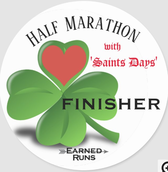 WEEKS 14-15 Runners, finally, on the last day of Week 14 training you proved you have what it takes to run 13 miles! But you’ll run it easy, with stops as needed. Walkers, you did it at the end of Week 15. Both groups are essentially ready to go the distance in competition now. These plans extend for 18 rather than 16 weeks to allow safe preparation, include a generous taper, and provide a little wiggle room to allow for minor training setbacks or other circumstances that prevent continuous training according to plan. The Earned Runs programs initial intention was to bring runners and walkers to their organized half marathon events’ starting lines in late April through mid-May. However, because of COVID-19 pandemic precautions continuing from 2020 into 2021, many half marathons are likely to again be postponed, cancelled, or converted to virtual format. There may be no need to taper through week 17 or 18! The taper is built into the schedule to help prevent injury and to boost performance under actual race conditions. If your race is personal or aimed at achieving a ‘soft’ record, there’s no reason to put it off. On the third Monday in April, the 19th of 2021, we should have been able to enjoy TV coverage of the 125th Boston Marathon. [It has again been re-scheduled in the fall and will take place on October 11.] Earned Runs usually advises runners to watch TV coverage and take note of the leaders’ running forms. Their heads would have been up, chests out, torsos tall and erect, shoulders loose and down, with elbows rhythmically pulled back. If it was possible to count the number of steps taken per 15 seconds (multiply by 4 to get steps/minute) to calculate cadence, you might have counted a number greater than 180, possibly up to 200. You would have had a chance to compare your form with that of the elites. When I had been advised to do this by a trainer to correct my form, I scoffed at the idea. I wasn’t an elite, was my thinking, so why run like one? I am a plodder, with a pace about 2.5 times greater than the best in the world. It would be pretentious! But I followed the advice and started to check out running form on all images, including magazine covers, ads, and online articles. All the pros displayed similar form. Athletes who dedicate their efforts 24/7 to being the best runners in the world and building professional running careers that span decades don’t adopt a certain form to look pretty in pictures; they do it to be fast and prevent sidelining injuries. I wanted to be fast and avoid injuries too, so tried to model my form on that of the elites, just like Coach instructed. There are other components to good form running. See the chart from New Balance on the RESOURCES page to refresh your memory. The secret to maintaining it throughout a long run is to build core, upper body, hip, leg and strength in training. The form for walking fast, but not race walking, is somewhat similar. I find that the greatest source of fatigue at the end of 13.1 miles comes from having a tired back, core, and arms. Which means there’s more work to do to become stronger in these areas. An additional benefit is that this work will translate into a more athletic posture. Those who counted on competing in an organized long-distance event, now postponed or cancelled, have been given extra time to work on strength, posture, and form. Summer and fall will hopefully bring an end to COVID-19 confinement, and perhaps we all will be stronger and better prepared to experience the joy of competing. Congratulations on finishing 13 miles! WEEK 16 There’s not much to do this week, as you are on the glide path to your half marathon race. Don’t overdo the long run at the end of the week. You want to be prepared and fresh for the race. An extra foam rolling session is scheduled next week for runners and walkers, but either/both can add extra sessions anytime. It can be a full or an abbreviated session. Use it to roll out sore and stiff spots any day of the week. If you are tempted to introduce new nutrition, shoes, gear, or apparel into your race preparations, be careful. Most experts would advise against making changes. There isn’t much time to truly test a new fuel strategy. Also, the runs/walks are not as demanding as earlier in the plan and can’t serve as adequate trials of new food or gear items for use on race day. New spring fashion upgrades can serve as zero-calorie rewards for following through on your commitment to train and finish a goal race! Enjoy them AFTER crossing the finish line. If you have not yet found an organized virtual race to run or walk, or plans have collapsed, consider pinning on an Earned Runs bib to be sure you meet the challenge of running or walking the half marathon for which you trained. Don’t let circumstances deter you from reaching your goal race! Request a set of bibs today to keep one in reserve, “just in case”. RUN & MOVE HAPPY! https://www.runnersworld.com/advanced/a20811880/soft-records/ https://www.baa.org/races/boston-marathon |
BRIDGE TO PHYSICAL SELF
Running, walking, and fitness activities enable us to experience our physical selves in a world mostly accessed through use of fingers on a mobile device. AuthorEARNED RUNS is edited and authored by me, runner and founder. In 1978 I began participating in 10K road races before 5Ks were common. I've been a dietitian, practiced and taught clinical pathology, and been involved with research that utilized pathology. I am fascinated with understanding the origins of disease as well as health and longevity. Archives
November 2023
CategoriesNew! Search Box
Earned Runs is now searchable! Check it out...
|
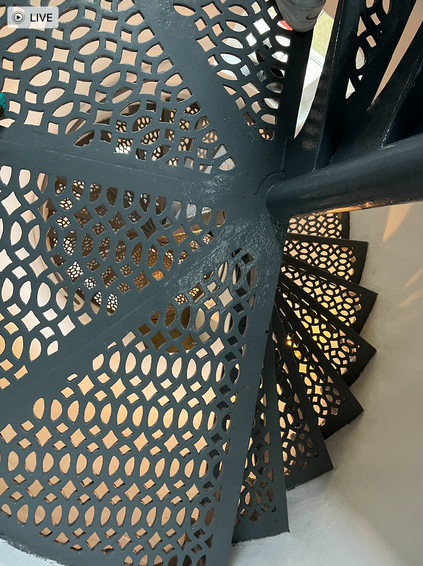
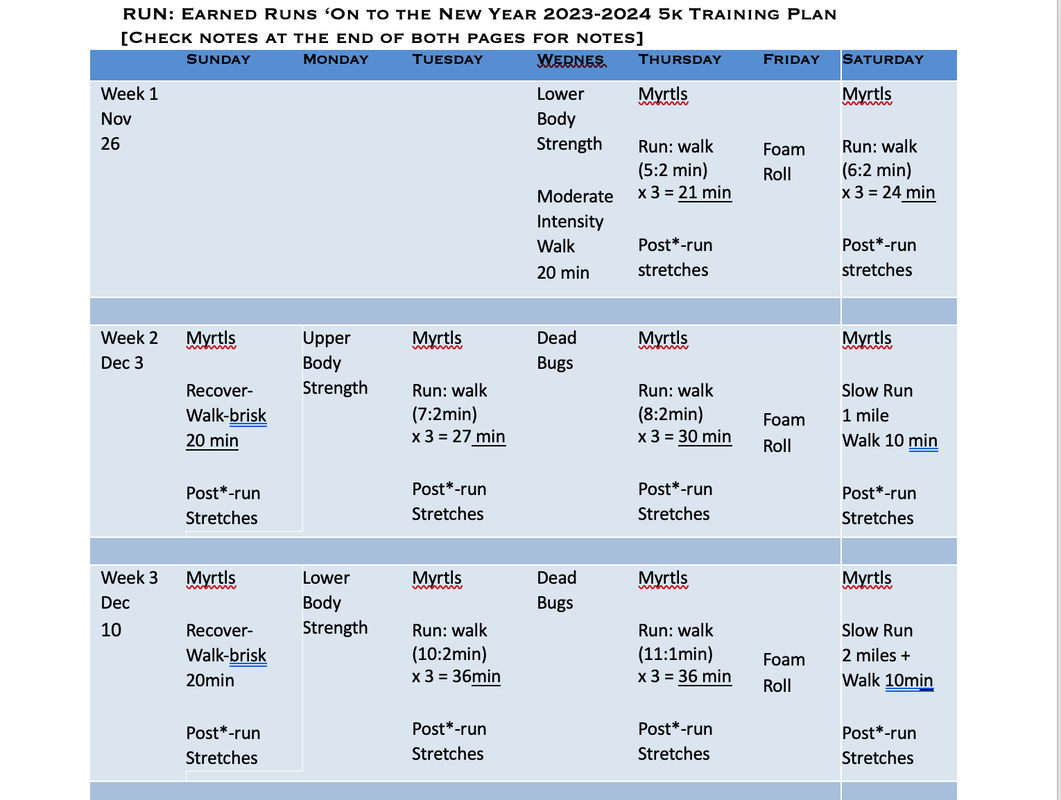



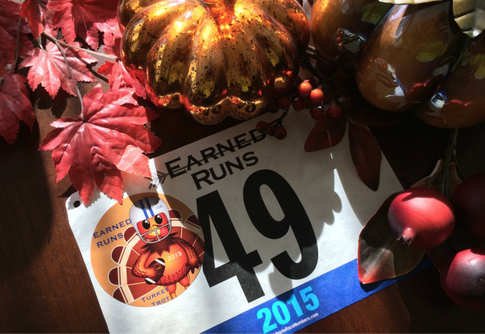
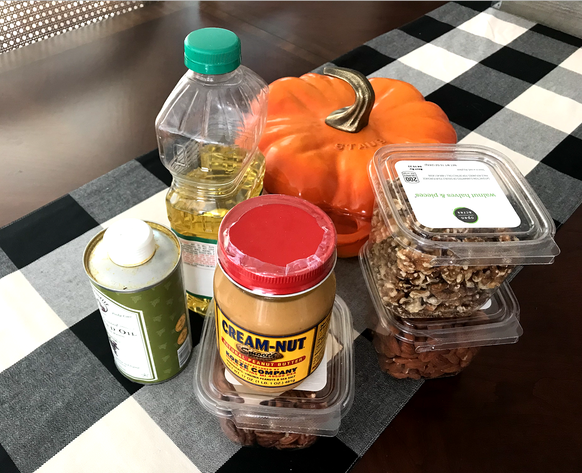
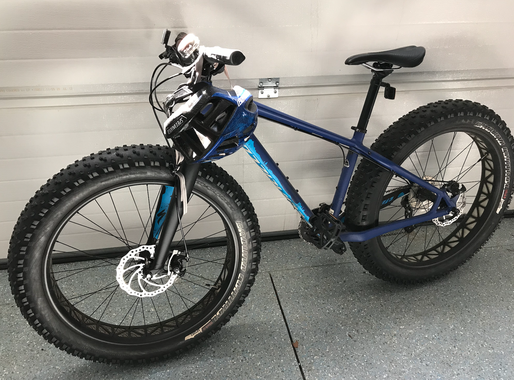

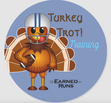

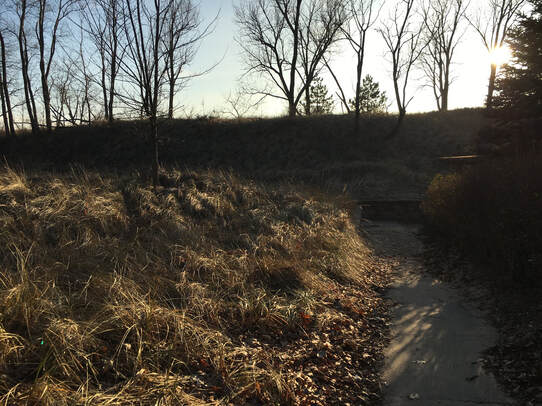
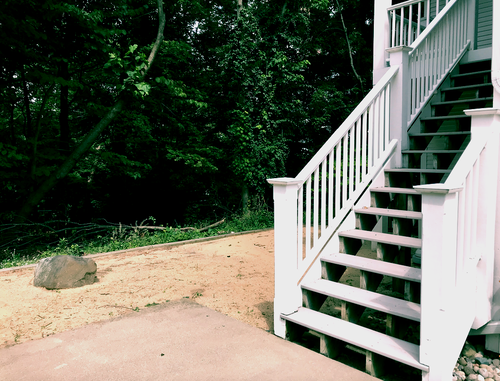

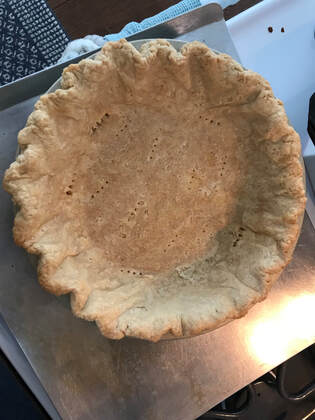
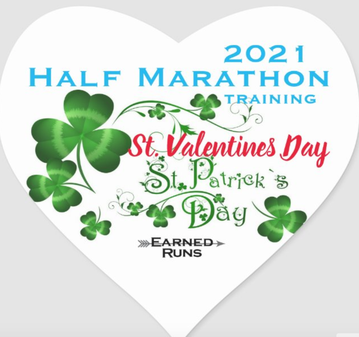
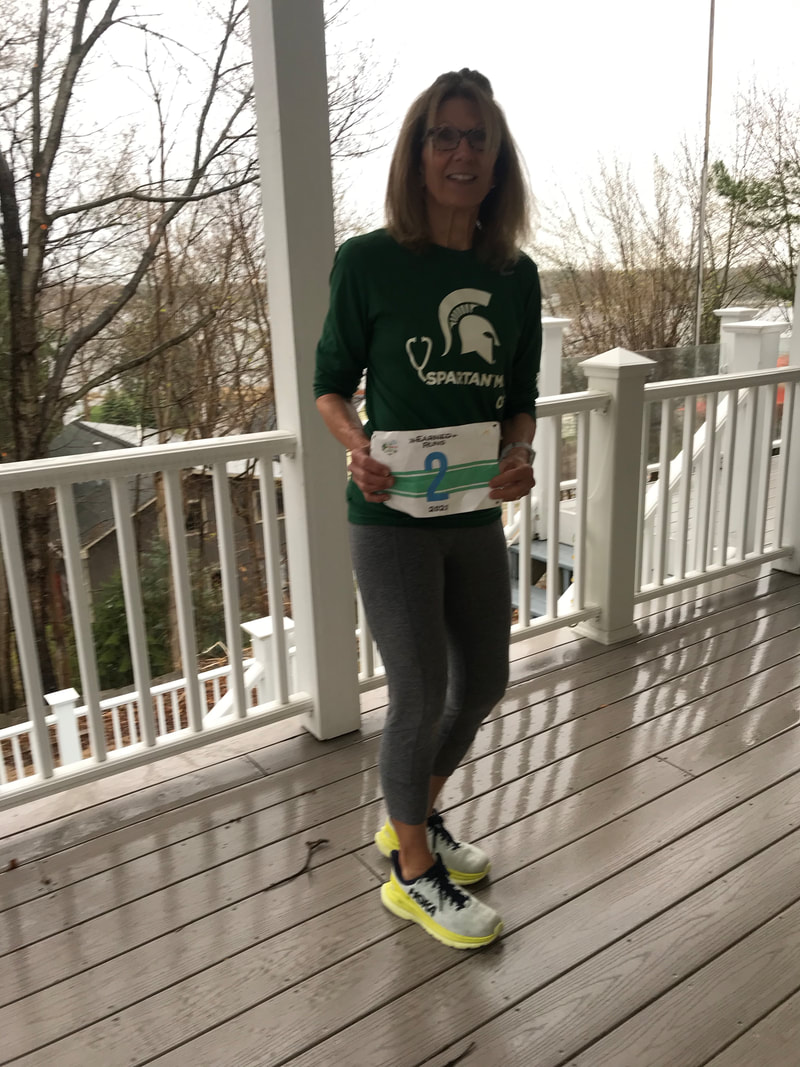
 RSS Feed
RSS Feed